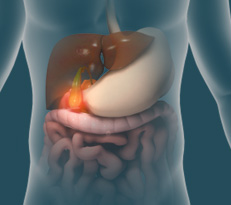
Gallbladder Anatomy and Function
The gallbladder is a small pear shaped organ in the right upper quadrant of the abdomen underneath the liver. It is connected to the common bile duct, which carries bile from the liver to the small intestine. It stores the bile made by the liver. During meals, a hormone signal causes the gallbladder to contract and empty extra bile into the intestine to assist with digestion.
Gallbladder Disease
When a gallbladder is inflamed or contains stones it cannot properly function. Although anyone can develop gallbladder disease, it is more common in women and people who are overweight or over the age of 35. There also appears to be a strong hereditary component of gallbladder disease.
Symptoms may include abdominal pain, nausea, vomiting, diarrhea, indigestion, bloating, fever, and, occasionally, jaundice. Abdominal pain is most commonly experienced in the right upper portion of the abdomen or just below the breast bone. While it often occurs after eating fried, greasy or fatty foods food, it can occur anytime. The pain may radiate to the back or into the chest and may be severe.
About Gallbladder austin surgeons
Diagnosis
Ultrasound is the most useful test to detect gallbladder disease. Ultrasound can identify gallstones and determine if acute inflammation is present by evaluating gallbladder wall thickness, presence of surrounding fluid and size of the common bile duct. A HIDA scan with or without CCK injection may also be used in atypical cases. A CT scan may be helpful but it is less sensitive.
Treatment
While some patients with mild or intermittent symptoms can be managed with dietary changes, surgical removal of the gallbladder is the treatment of choice when patients become symptomatic. Even when symptoms are mild or absent, gallstones can produce sudden and severe illness including liver obstruction or pancreatitis.
Laparoscopic Cholecystectomy
Removal of the gallbladder is one of the most commonly performed operations. General anesthesia is utilized. The surgery is usually performed by laparoscopy, in which a camera is inserted through a small incision at the navel and used to view the gallbladder. Narrow instruments are inserted through three other small incisions, usually placed along the right rib margin. Carbon dioxide gas inflates the abdomen and creates space in which to work. The gallbladder is freed up and removed. A cholangiogram (x-ray test of the bile ducts) is frequently done as well.
Occasionally, severe infection, internal scarring, or other problems prevent completion of the operation with the laparoscope. In this case, the operation is completed through a standard “open” incision. You many learn more about laparoscopic surgery here about Laparoscopic Cholecystectomy.
Recovery
Laparoscopic surgery allows for a much quicker recovery and less postoperative pain than traditional open surgery. Most patients can go home the same day as surgery, however a few may need to stay overnight. Post-operative pain is usually well-controlled with prescribed pain medications. There will be small white gauze pads over incisions which may be removed 24 hours after surgery. Under the gauze pads will be either small pieces of tape called Steri-Strips, or glue covering the incisions. These should be left alone as they will fall off over time. Patients may shower 24 hours after surgery and can resume usual activities over the 3-5 days following surgery. Patients should avoid lifting over pounds for 3 weeks and avoid greasy or fatty foods for two weeks. A follow-up appointment with the surgeon should be 1 or 2 weeks after surgery.
Complications
Although complications from gallbladder surgery are rare, they may occur and include:
- Bleeding or infection
- Injury to organs (liver, stomach, intestines, bile ducts, others)
- “Bile duct injury leak”, blockage, or retained stones
- Pancreatitis
- Diarrhea or other post cholecystectomy symptoms
- Need for open surgery or other procedures, including endoscopic removal of bile duct stones
- Complications from anesthesia
